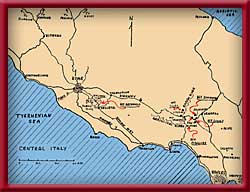
ITALIAN CAMPAIGN
BATTLE FOR MT. MAGGIORE
 On 2 December, 600 American and British guns
put on a huge, synchronized artillery barrage on Mt. Maggiore in preparation for what
became a successful attack by the 36th Division’s 142nd Regiment. Large caliber
German artillery then interdicted supply lines to the 142nd for some time before the
mountain was entirely secured. Mt. Maggiore became known as the "million dollar
mountain" because of the huge amount of ammunition expended, and artillerymen called
the barrage the "Serenade to Mussolini and Hitler". During this action the
German multiple rockets or nebelwerfers were encountered for the first time. Men referred
to them as "screaming meemies" because of the sound they made as they blasted
through the tortured air. Two battalions of the German 71st Nebelwerfer Regiment were
identified from prisoners taken. They reported that the American artillery had destroyed
four of their weapons. On 2 December, 600 American and British guns
put on a huge, synchronized artillery barrage on Mt. Maggiore in preparation for what
became a successful attack by the 36th Division’s 142nd Regiment. Large caliber
German artillery then interdicted supply lines to the 142nd for some time before the
mountain was entirely secured. Mt. Maggiore became known as the "million dollar
mountain" because of the huge amount of ammunition expended, and artillerymen called
the barrage the "Serenade to Mussolini and Hitler". During this action the
German multiple rockets or nebelwerfers were encountered for the first time. Men referred
to them as "screaming meemies" because of the sound they made as they blasted
through the tortured air. Two battalions of the German 71st Nebelwerfer Regiment were
identified from prisoners taken. They reported that the American artillery had destroyed
four of their weapons.
During the night of 6 December 36th Division artillery began "softening up"
the strong German defenses on Mt. Sammucro and around San Pietro. With enemy observation
posts on Mt. Lungo (astride the highway and between Mt. Maggiore and Mt. Sammucro)
observing American movements, the 2nd and 3rd Battalions of the 143rd Regiment attacked in
the rain to avoid close surveillance by the Germans. Several attacks on San Pietro were
unsuccessful but the regiment’s 1st Battalion made a back-breaking, five hour climb
up steep Mt. Sammucro in zero weather and against boulders loosened and rolled down upon
them by the German defenders. The mountain was captured and held in spite of seven enemy
counterattacks. Thus all the enemy well-organized positions were exposed to American
observation as far as San Vittore. Enemy counterattacks continued against Mt. Maggiore and
elements of the Herman Goering Division began arriving to bolster the German defenses.
With Mt. Maggiore, south of Highway 6, and Mt. Sammucro, north of the highway, firmly
under control, the 36th Division had only to take Mt. Lungo, astride the highway, to
effect a breakthrough. The day following the capture of the two mountains, a break in the
weather brought renewed enemy air attacks. Platoon C-1 fought off a vicious, strafing and
bombing attack on the 131st Field Artillery by shooting down three German planes. The crew
manned the guns despite direct strafing and anti-personnel bombing. They continued to fire
until a direct bomb hit killed one man and wounded five others, one for the second time
that month. All were recommended for the Silver Star. Several hours later Platoon B-2
destroyed one of a flight of eight Me-109s and four Focke-Wulfs attacking the 155th Field
artillery just east of Mignano. The following day the same platoon shot down another
ME-109.
On 14th December the newly constituted Italian 1st Motorized Brigade attempted to take
Mt. Lungo but went into a German trap and lost over 400 men killed or wounded. The Brigade
was withdrawn and the 36th Division’s 142nd Regiment was ordered to seize Mt. Lungo.
In early morning of 15th December, two 142nd battalions were hidden on the lower slopes of
Mt. Maggiore. When evening came, the 2nd Battalion moved around Mt. Lungo to strike the
Germans from the south while the 1st Battalion crossed the valley to attack from the west.
The enemy was completely surprised — many still asleep in their foxholes. Mopping up
continued all night and at daylight, their positions no longer tenable, the Germans
withdrew from battle-scarred San Pietro. At 9:30 am Platoons B-1 and B-2 shot down two of
14 FW 190s attacking the 133rd Field Artillery in its new positions, just east of San
Pietro.
On 20 December the 2626 AAA Brigade was redesignated the 71st AAA Brigade. And on
Christmas Day the 443rd Band played for the 36th Division Commander at his staff at
Christmas dinner. Their "Eyes of Texas Are Upon You" and "The Yellow Rose
of Texas" brought plaudits and a letter of appreciation to the 443rd Battalion
Commander as follows:
"I desire to express my appreciation, in which I am joined by officers of
Division Headquarters, for your thoughtfulness in sending the orchestra of your Battalion
to entertain us during Christmas dinner. Please express to members of the orchestra our
appreciation for their fine entertainment". - Fred L. Walker, Major General, U.S.
Army, Commanding, 36th Infantry Division.
|